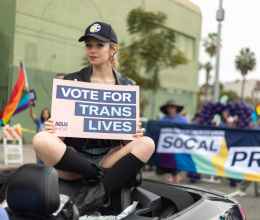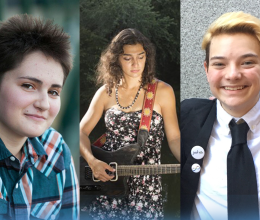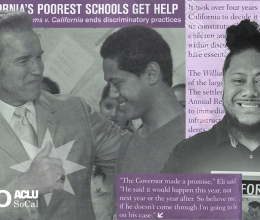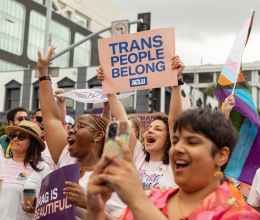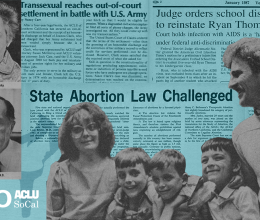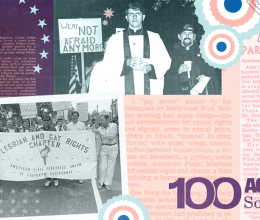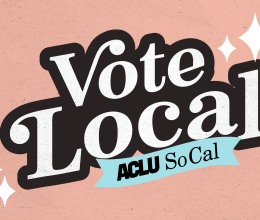
Why They DON'T Solve the Problem of Anti-LGBTQ Bullying
A FACT SHEET FROM THE ACLU OF CALIFORNIA
What is the problem?
Lesbian, gay, bisexual, transgender and questioning ("LGBTQ") students face extraordinary levels of hostility and bullying (or harassment) in school. In a recent national survey, nearly 9 out of 10 LGBT students reported being harassed in their middle or high school based on their sexual orientation, and almost a third of LGBT students reported skipping at least one day of school in the past month because of safety concerns.1
What are Zero Tolerance policies?
Zero Tolerance policies require schools to suspend or expel students for violating rules, no matter what extenuating circumstances there might be. Zero Tolerance policies are often put in place — either through state law or school district policies — in response to the failure of school districts to address the very real problem of anti-LGBTQ bullying. But contrary to popular belief, Zero Tolerance policies don't actually help LGBTQ students, and in fact are likely to harm them.
Why don't Zero Tolerance policies help protect LGBTQ students?
Zero tolerance policies . . .
- DON'T improve school safety or climate. The assumption behind Zero Tolerance policies is that removing dis- ruptive students from school will deter other students from disruption and create an improved school climate. But research shows that the opposite is in fact true — schools with high suspension and expulsion rates have worse school climates and higher rates of suspension and misbehavior.2
- DON'T stop the bullies from bullying. Suspension and expulsion don't result in changed behavior, and they could lock in that behavior. Studies of school suspension show that up to 40% of school suspensions are for repeat offenders, leading researchers to conclude that, for those students, "suspension functions as a reinforcer . . . rather than a punisher."3
- ARE used against LGBTQ students more than straight students. Research also shows that Zero Tolerance policies are disproportionately used against vulnerable student populations, including students of color, students with disabilities, and LGBTQ students. A recent study concluded that LGBTQ students were 1.25 to 3 times likelier to get punished at school than their heterosexual peers.4 What this means is that the LGBTQ student who fights back against bullying is more likely to be punished than the bully.
Are there effective ways to protect LGBTQ students from bullying?
Yes! Studies have found that LGBTQ students experienced a safe, more positive school environment when:
- Their school had a Gay-Straight Alliance (GSA) or similar student club;
- They were taught positive representations of LGBTQ people, history, and events through their school curriculum;
- They had a school administration that was supportive of LGBTQ students and school staff who intervened when they witnessed bullying and effectively responded to complaints of bullying;
- Their school had a comprehensive anti-bullying policy that specifically included protections based on sexual orientation and gender identity; and
- Their school was in a state with a comprehensive anti-bullying law that specifically included protections based on sexual orientation and gender identity.5
What can you do or your group do to help protect LGBTQ students?
- If your state doesn't have an anti-bullying law that specifically includes protections based on sexual orientation and gender identity, try to get one passed;
- If your school district doesn't have an anti-bullying policy that specifically includes protections based on sexual orientation and gender identity, try to get one passed;
- If your school district doesn't have a complaint procedure for bullying complaints, try to get one put in place;
- Ask your school district or school to train staff about anti-LGBTQ bullying and how to intervene when they see it happening;
- Ask your school district or school to support GSAs or other affirming clubs and activities for LGBTQ students; and
- Ask your school district or school to integrate LGBTQ people, history, and events into the curriculum.
1 A Report from the Gay, Lesbian and Straight Education Network, The 2009 National School Climate Survey: The Experience of Lesbian, Gay, Bisexual and Transgender Youth in Our Nation's School, p.15 (2010) ("GLSEN 2009 School Climate Survey"), available at http://www.glsen.org/binary-data/GLSEN_ATTACHMENTS/file/000/001/1675-2.pdf. top
2 APA Zero Tolerance Task Force, Are Zero Tolerance Policies Effective in the Schools, 63 American Psychologist 852, 860 (Dec 2008), available at http://www.apa.org/pubs/info/reports/zero-tolerance.pdf. top
3 Russell J. Skiba, Zero Tolerance, Zero Evidence: An Analysis of School Disciplinary Practice, Indiana Education Policy Center, p.13 (Aug. 2000), I http://www.indiana.edu/~safeschl/ztze.pdf. top
4 Kathryn E. W. Himmelstein & Hannah Brückner, Criminal-Justice and School Sanctions Against Nonheterosexual Youth: A National Longitudinal Study, 127 Pediatrics 49, 54 (Jan. 2011), available at http://www.pediatrics.org. top
5 GLSEN 2009 School Climate Survey, p.63. top
